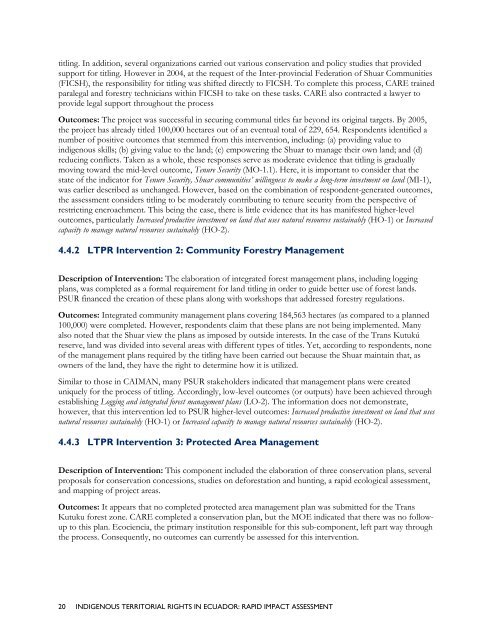ECUADOR - Land Tenure and Property Rights Portal
ECUADOR - Land Tenure and Property Rights Portal
ECUADOR - Land Tenure and Property Rights Portal
- No tags were found...
Create successful ePaper yourself
Turn your PDF publications into a flip-book with our unique Google optimized e-Paper software.
titling. In addition, several organizations carried out various conservation <strong>and</strong> policy studies that providedsupport for titling. However in 2004, at the request of the Inter-provincial Federation of Shuar Communities(FICSH), the responsibility for titling was shifted directly to FICSH. To complete this process, CARE trainedparalegal <strong>and</strong> forestry technicians within FICSH to take on these tasks. CARE also contracted a lawyer toprovide legal support throughout the processOutcomes: The project was successful in securing communal titles far beyond its original targets. By 2005,the project has already titled 100,000 hectares out of an eventual total of 229, 654. Respondents identified anumber of positive outcomes that stemmed from this intervention, including: (a) providing value toindigenous skills; (b) giving value to the l<strong>and</strong>; (c) empowering the Shuar to manage their own l<strong>and</strong>; <strong>and</strong> (d)reducing conflicts. Taken as a whole, these responses serve as moderate evidence that titling is graduallymoving toward the mid-level outcome, <strong>Tenure</strong> Security (MO-1.1). Here, it is important to consider that thestate of the indicator for <strong>Tenure</strong> Security, Shuar communities’ willingness to make a long-term investment on l<strong>and</strong> (MI-1),was earlier described as unchanged. However, based on the combination of respondent-generated outcomes,the assessment considers titling to be moderately contributing to tenure security from the perspective ofrestricting encroachment. This being the case, there is little evidence that its has manifested higher-leveloutcomes, particularly Increased productive investment on l<strong>and</strong> that uses natural resources sustainably (HO-1) or Increasedcapacity to manage natural resources sustainably (HO-2).4.4.2 LTPR Intervention 2: Community Forestry ManagementDescription of Intervention: The elaboration of integrated forest management plans, including loggingplans, was completed as a formal requirement for l<strong>and</strong> titling in order to guide better use of forest l<strong>and</strong>s.PSUR financed the creation of these plans along with workshops that addressed forestry regulations.Outcomes: Integrated community management plans covering 184,563 hectares (as compared to a planned100,000) were completed. However, respondents claim that these plans are not being implemented. Manyalso noted that the Shuar view the plans as imposed by outside interests. In the case of the Trans Kutukúreserve, l<strong>and</strong> was divided into several areas with different types of titles. Yet, according to respondents, noneof the management plans required by the titling have been carried out because the Shuar maintain that, asowners of the l<strong>and</strong>, they have the right to determine how it is utilized.Similar to those in CAIMAN, many PSUR stakeholders indicated that management plans were createduniquely for the process of titling. Accordingly, low-level outcomes (or outputs) have been achieved throughestablishing Logging <strong>and</strong> integrated forest management plans (LO-2). The information does not demonstrate,however, that this intervention led to PSUR higher-level outcomes: Increased productive investment on l<strong>and</strong> that usesnatural resources sustainably (HO-1) or Increased capacity to manage natural resources sustainably (HO-2).4.4.3 LTPR Intervention 3: Protected Area ManagementDescription of Intervention: This component included the elaboration of three conservation plans, severalproposals for conservation concessions, studies on deforestation <strong>and</strong> hunting, a rapid ecological assessment,<strong>and</strong> mapping of project areas.Outcomes: It appears that no completed protected area management plan was submitted for the TransKutuku forest zone. CARE completed a conservation plan, but the MOE indicated that there was no followupto this plan. Ecociencia, the primary institution responsible for this sub-component, left part way throughthe process. Consequently, no outcomes can currently be assessed for this intervention.20 INDIGENOUS TERRITORIAL RIGHTS IN <strong>ECUADOR</strong>: RAPID IMPACT ASSESSMENT
















